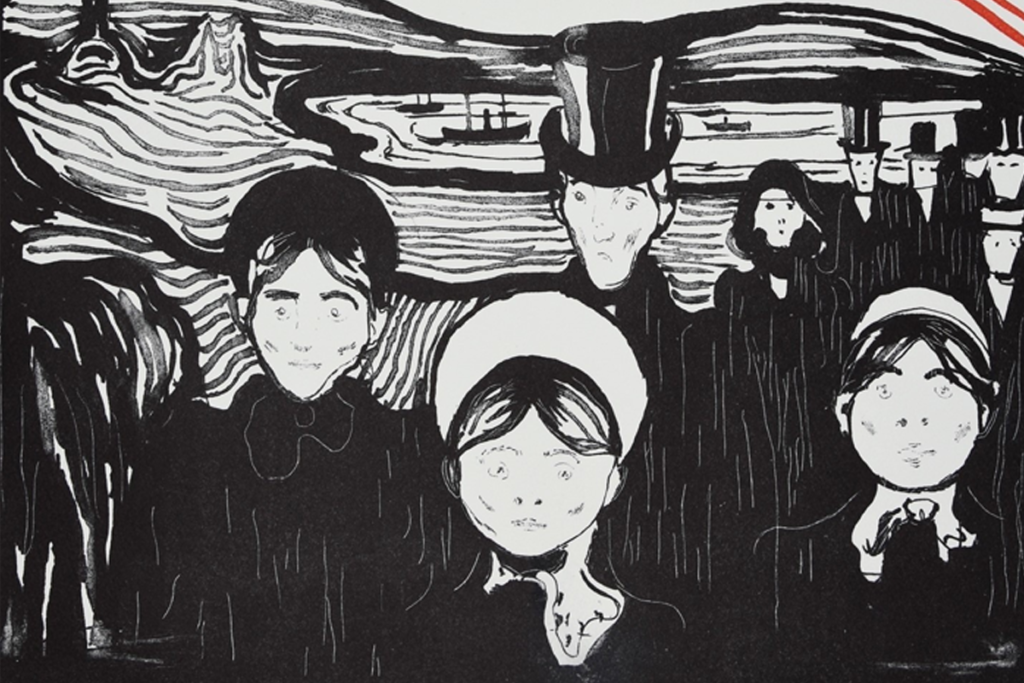Edvard Munch, “Angst” (Anxiety) 1896, litograph, 22 1/2 × 16 9/10 in. (|57.2 × 43 cm), Yale University Art Gallery, Special Exhibition: Munch and Kirchner: Anxiety and Expression.


Last Thursday, February 29th, 2024, a group of brothers attended the temporary exhibition, Munch and Kirchner: Anxiety and Expression, at the Yale University Art Gallery with our Art History professor. We also had the opportunity to participate in the Exhibition Opening Lecture, Munch and Kirchner: Expressions of Anxiety, by Jay A. Clarke. Walking through the gallery, and having listened to the lecture, it was as if Munch’s emotions spoke to me in cries of despair through the artworks. Of all the prints, one intrigued me in a particular way: Angst (Anxiety), a lithograph made in 1896.
This artwork can be explained by the title itself. Only two colors are present in the lithograph: the red ochre lines that mark the sky at sunset and the black lines of the landscape and the approaching human figures. The faces of the human group stare at whomever approaches this print, and their gazes are not friendly but rather full of suspicion; provoking tension and anxiety. The gazes on their faces seem to look at me as someone alien. From my point of view, Munch is expressing here the alienation many human beings experienced at the beginning of the last century. This alienation will be a recurring theme in literature and philosophy; the visual arts are no exception.
«Munch was an explicit autobiographical painter whose themes of anxiety, death, and despair were related directly to his experiences as a child. […] he suffered from mental health problems throughout his life»[1]. Indeed, the central theme of the lecture we heard, and the exhibition we visited, is the artists’ expression of their mental problems through their art. I find this to be the key when approaching modern art: do not expect to see the traditional sublime canons of beauty or the sacredness of a religious artwork; instead, let the artist’s inner life speak to you through what he has created. In many cases, as in Munch’s, we will find pain and suffering.
Sister Wendy Beckett made the distinction between religious art and spiritual art[2]. Munch’s Angst, for example, is a spiritual work because it speaks of the inner suffering and anxiety of the artist. It gives me pause to reflect on my role as a religious: the work of art provides us with a glimpse of the pain and alienation present in the modern world, were many proclaimed that God is dead, as Nietzsche said four years before Munch’s lithograph was printed[3]. Angst is a spiritual work because it speaks of man’s spiritual thirst in the modern world. As religious, it helps us to contemplate the suffering of a world without God; a situation we want to change. In my future apostolate, I would use this lithograph to explain, precisely, the terrible consequences of a life without God.
[1] L. SCHNEIDER ADAMS, Nineteenth-Century Art, Oneworld Publications, Nordhavn 2014, p. 185.
[2] Cf. W. BECKETT, Joy Lats. On the Spiritual in Art, Getty Publications, Los Angeles 2006.
[3] Cf. F. NIETZSCHE, La Gaya Ciencia, Edaf, Madrid 2011.



